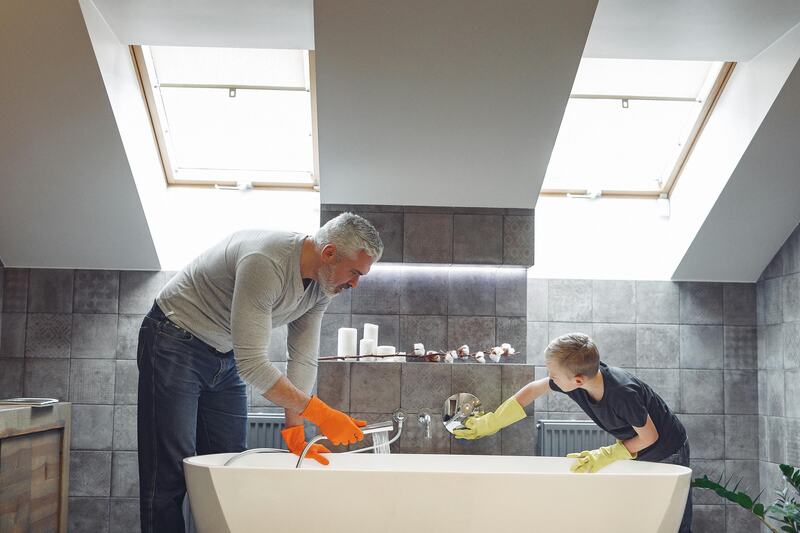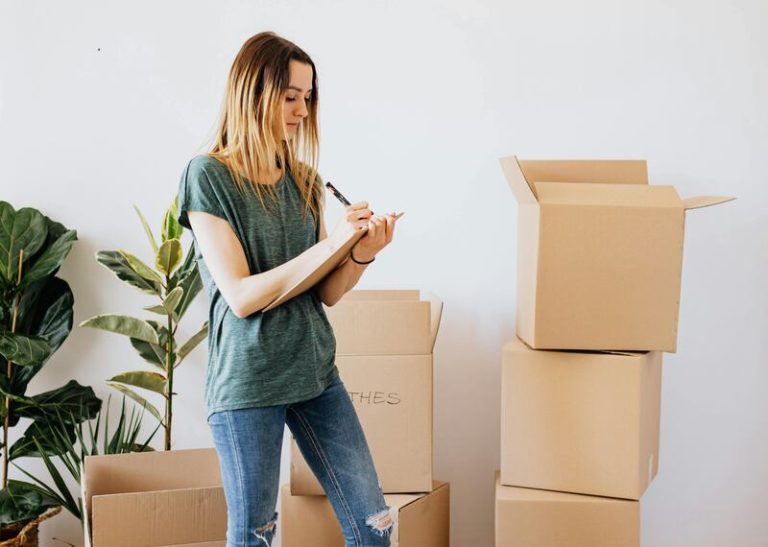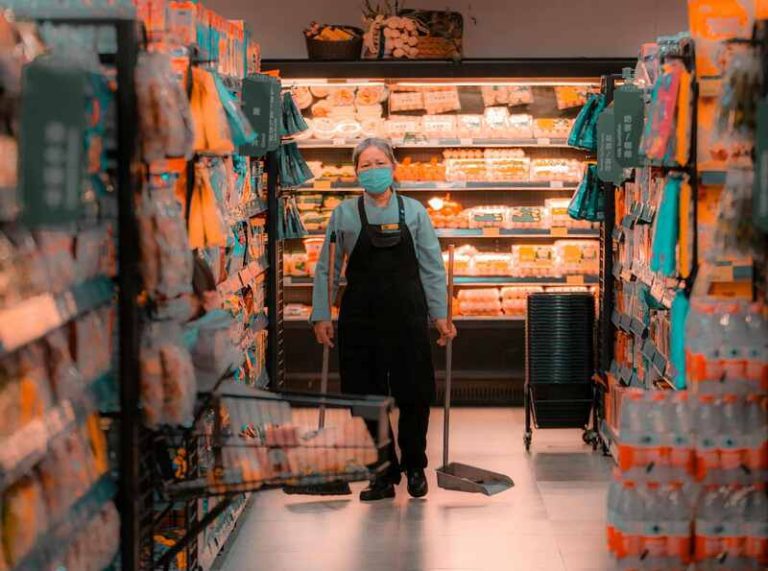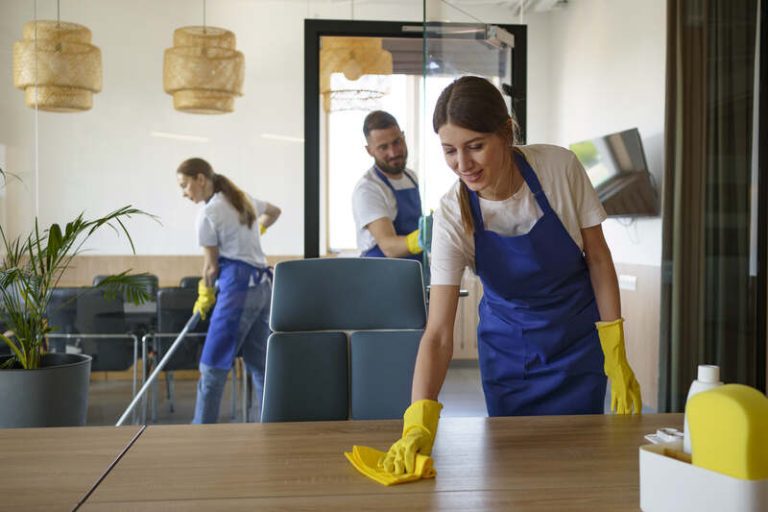Are you wondering why taking a bathroom cleaning guide is so important? Well, from the toilet to the floor, every part of your bathroom needs regular cleaning to keep the space hygienic and pleasant.
In this article, we will discuss what order should you clean a bathroom and also what parts of a bathroom do we need to clean.
Not only that, in this bathroom cleaning guide, we will also share some tips on how to keep your bathroom clean. Let’s dive in!
What Parts of A Bathroom Do We Need to Clean?
In terms of residential bathroom cleaning, it is essential to focus on various parts including:
a. Toilet
The toilet is one of the most critical areas of the bathroom to clean, as it can harbour a significant amount of bacteria and germs.
Thoroughly cleaning the toilet involves a few essential steps to ensure proper sanitation. Begin by applying a strong toilet cleaner to the inside of the bowl, allowing it to sit and work its magic.
While the cleaner is doing its job, use a toilet brush to scrub away any lingering stains and grime. Once the bowl is sparkling clean, don’t forget to disinfect the exterior surfaces as well, including the handle and seat.
b. Sink and Countertop
Cleaning the basin and worktop is essential to remove stains, watermarks, and bacteria that accumulate from daily use.
Start by clearing the basin and worktop of any items or debris. Next, sprinkle bicarbonate of soda or white vinegar on tough stains, letting it sit for a few minutes to loosen them.
Scrub the basin with a gentle scrubbing brush or sponge, focusing on the edges and around the plughole. For stubborn stains, mix bicarbonate of soda and lemon juice into a paste for extra cleaning power.
Don’t forget to disinfect the surfaces by using a disinfectant spray or wipe to reduce germs. Pay special attention to tap handles, as they can harbour a lot of bacteria.
To maintain a sparkling finish, rinse the basin and worktop thoroughly with water and dry them with a clean cloth. Consider finishing off with a polish for added shine.
c. Bathtub and Shower
The bath and shower require regular cleaning to prevent the build-up of mould, mildew, and soap scum.
For a thorough cleaning process, start by spraying a mixture of equal parts water and white vinegar on the tile grout. Let it sit for about 15-20 minutes to penetrate the grime before scrubbing with a stiff-bristled brush. Rinse the grout with water to remove the vinegar solution.
To tackle stubborn mould and mildew stains, use a mould and mildew remover. Apply the cleaner according to the manufacturer’s instructions and allow it to sit for the recommended time before scrubbing the affected areas.
Cleaning the glass shower doors can be done effectively using a quality glass cleaner. Spray the cleaner liberally on the doors, ensuring all areas are covered. Wipe the doors clean with a microfibre cloth or a squeegee to remove any streaks and water spots, leaving your shower sparkling.
d. Floors
Bathroom floors need to be cleaned regularly to remove dust, hair, and other debris, which can accumulate quickly.
For a deeper clean, using a steam mop can be highly effective. The hot steam not only cleans the surface but also sanitises it, killing germs and bacteria. Be cautious with steam mops on certain delicate floorings, so always check the manufacturer’s recommendations for compatibility.
e. Mirrors and Windows
Keeping mirrors and windows clean in the bathroom is essential for maintaining a streak-free and clear view.
One of the best practices for achieving a crystal-clear finish on mirrors and windows is to use a high-quality glass cleaner. Opt for a cleaner specifically formulated for glass surfaces to ensure the effective removal of dirt, grime, and streaks.
When applying the cleaner, spray it directly onto a microfibre cloth rather than the glass surface to prevent oversaturation.
For those hard-to-reach spots such as upper windows or mirrors, consider using a telescopic window cleaning kit with an adjustable handle. This will allow you to extend your reach without compromising on precision.
f. Cabinets and Drawers
Cleaning and organising cupboards and drawers in the bathroom helps maintain a tidy and hygienic space. Start by emptying out all the items from the cupboards and drawers, and sorting them into categories: skincare products, hair care, toiletries, etc.
Once everything is out, thoroughly dust the interior of the cupboards and drawers to remove any build-up. Then, take a disinfectant spray or wipes and clean the surfaces to eliminate germs and bacteria.
It’s important to discard any expired or unused items during this process to declutter effectively. After cleaning, consider using drawer dividers or small storage containers to keep everything organised and easily accessible.
What Supplies Do You Need for Cleaning a Bathroom?
To effectively clean a bathroom, you’ll need a variety of cleaning supplies, including:
- Microfibre cloths: an essential tool for cleaning bathroom surfaces due to their ability to trap dirt and bacteria without leaving streaks.
- Scrub brushes: perfect for tackling tough grime and soap scum buildup on tiles and grout.
- Disinfecting wipes: provide a convenient way to quickly sanitise high-touch areas such as doorknobs and faucets.
- Vinegar: a natural alternative to harsh chemicals, vinegar can effectively break down soap scum and mineral deposits in the bathroom while also acting as a disinfectant.
- Baking soda: ideal for scrubbing and deodorising, baking soda is gentle on surfaces and can remove stains without causing damage.
For those with sensitivities or a preference for natural cleaning products, vinegar and baking soda can serve as excellent alternatives to traditional chemical cleaners, offering effective cleaning power without the strong odours or potential irritants.
Step-by-Step Bathroom Cleaning Guide
If you’re still confused about how to clean everything in your bathroom, here’s a step-by-step guide that you can follow:
a. Preparing the Bathroom
Before starting to clean, prepare the bathroom by gathering all your cleaning supplies and decluttering the space.
Ensuring that the bathroom is well-prepped before diving into the cleaning process can make the task much more efficient and effective. Clearing out personal items from the counters and surfaces not only creates a more conducive environment for cleaning but also helps in reaching all the nooks and corners without any hindrance.
Remember to turn on the bathroom fan or open a window to allow proper ventilation. This helps in preventing the build-up of strong odours from cleaning products and ensures a fresh, breathable atmosphere during and after the cleaning session. Having all your supplies within reach saves time and avoids the hassle of scrambling to find them midway through the task.
b. Cleaning the Toilet
Cleaning the toilet involves scrubbing the bowl with a toilet brush and a strong cleaner, followed by disinfecting the surfaces.
Next, it is crucial to pay attention to the hard-to-reach areas of the toilet. Use a toilet brush to clean under the rim and around the hinges. For a thorough clean, consider using disinfecting wipes to sanitise the seat, handle, and other frequently touched surfaces.
After scrubbing and disinfecting, let the cleaner sit for a few minutes to ensure maximum effectiveness. Flush the toilet to rinse away any residue and give the toilet a fresh, clean appearance. Regular maintenance with these steps will help keep your toilet clean and hygienic.
c. Cleaning the Sink and Countertop
To clean the sink and worktop, remove any stains and watermarks, and disinfect tap handles and other high-touch areas.
Start by clearing the sink and worktop of any dishes or clutter. Sprinkle bicarbonate of soda over the surfaces to tackle tough stains – its gentle abrasive nature works wonders. Then, use a soft sponge or cloth to scrub away the grime, making sure to reach all corners and edges. Rinse thoroughly with warm water.
For disinfection, mix equal parts water and white vinegar in a spray bottle. Spritz this solution on tap handles, knobs, and any other frequently touched spots. Let it sit for a few minutes before wiping it clean with a damp cloth.
d. Scrubbing the Bath and Shower
Scrubbing the bath and shower is necessary to remove mould, mildew, and soap scum, especially from tile grout and other crevices.
Begin by clearing the area of any personal care products, towels, and bath mats to access all surfaces that need cleaning. Use a specialised bathroom cleaner that is effective against mould and mildew, ensuring it is safe for the specific material of your bath and shower.
Pay close attention to the grout lines, corners, and fixtures, as these are areas often overlooked but prime spots for mould buildup. A stiff-bristled brush or an old toothbrush can be invaluable for scrubbing these hard-to-reach areas.
Don’t forget to clean the shower curtain or door, as they can harbour soap scum and mould too. For stubborn stains, a mixture of bicarbonate of soda and vinegar can work wonders, while a squeegee is perfect for preventing water spots on glass surfaces.
e. Mopping the Floors
Mopping the bathroom floors helps to remove dust, hair, and other debris, ensuring a clean and hygienic surface.
To achieve the best results when mopping, it is essential to first vacuum or sweep the floor to get rid of larger particles that could get stuck in the mop. Once the floor is prepped, mix warm water with a low-foaming cleanser to avoid leaving a residue after mopping.
Using a steam mop can be a great way to ensure a deeper clean, as the hot steam can effectively sanitize and remove stubborn grime.
f. Wiping Mirrors and Windows
Wiping mirrors and windows with a glass cleaner and a microfibre cloth ensures a streak-free and clear finish.
For mirrors and windows in hard-to-reach areas, try using a squeegee with a long handle to easily clean without straining or risking accidents. Ensuring that the glass cleaner is specifically formulated for glass surfaces will lead to better results, preventing streaks and residue.
Using a solution of vinegar and water can be a cost-effective and eco-friendly alternative to store-bought cleaners, providing a streak-free shine. When cleaning, start from top to bottom to prevent drips and ensure a thorough finish. Avoid cleaning in direct sunlight as it can cause the cleaner to dry too quickly, resulting in streaks.
g. Organising Cabinets and Drawers
Organising cupboards and drawers involves removing all items, dusting and disinfecting the surfaces, and decluttering as you put things back in place.
After decluttering, it’s essential to categorise similar items together to streamline your routine. Use storage boxes, dividers, and trays to keep things organised and easier to find. Utilise vertical space by installing shelves or hooks inside the cupboards for extra storage options. Consider labelling containers or drawers to know exactly where everything belongs, making it simpler to maintain order in the long run. Regularly assess the contents of your bathroom storage areas to purge any expired products or items you no longer need.
Tips for Maintaining a Clean Bathroom
Maintaining a clean bathroom involves regular weekly tasks and using the right products to disinfect and keep surfaces spotless.
One of the essential weekly tasks is to clean the toilet thoroughly using a disinfectant or toilet bowl cleaner. It is also important to wipe down the sink, countertops, and any other surfaces with an antibacterial spray or wipes to prevent the spread of germs.
When choosing cleaning products, opt for those specifically designed for bathrooms to effectively combat soap scum, mould, and mildew. Look for products with antimicrobial properties to ensure a deep clean and protection against bacteria.
Developing good habits can help prevent the build-up of grime and bacteria. Encourage household members to hang up towels after use, squeegee the shower walls after each use, and regularly clean shower curtains to prevent mould growth.
From the bathroom cleaning guide above, now you know how to clean a home bathroom properly and effectively.
At its core, regular bathroom cleaning is essential not only to keep the space visually appealing but also to ensure a healthy environment by removing bacteria, mould and other harmful substances.
However, achieving this level of cleanliness consistently can be challenging and time-consuming. That’s where TEKA Cleaning comes in. Our residential cleaning services ensure that every nook and cranny of your bathroom is thoroughly cleaned and sanitised by professionals.
By entrusting your bathroom cleaning to TEKA Cleaning, you not only save valuable time but also ensure a healthier home environment for you and your family. Don’t leave the health and hygiene of your bathroom to chance. Contact TEKA Cleaning today at 01233 751 544 and experience the difference our expert services can make.
Read also:










